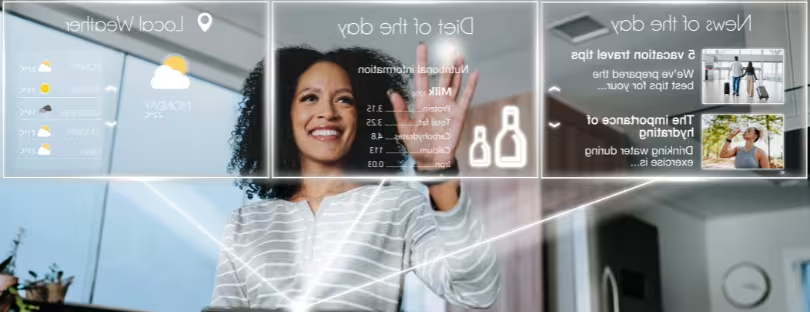
The Diverse Applications of Augmented Reality
The augmented reality market is on the brink of impressive growth, as indicated by a report from Research Dive. The market is predicted to register revenue of $411,396.9 million by 2031, growing at a healthy CAGR of 33.2% during the forecast period 2022-2031. augmented reality examples
Augmented reality (AR) is a technology that blends digital information and virtual objects with the real world in real time. It involves the use of devices, such as smartphones or AR glasses, to overlay digital content, such as images, sounds, and text, onto the physical environment. This technology enables users to experience a hybrid reality that enhances their perception of the real world by adding relevant and interactive digital information to their physical surroundings.
With the increasing use of augmented reality technology in the healthcare sector and the growing adoption of AR technology in the gaming sector, the market is expected to surge in the coming years.
Dynamics of the Market augmented reality examples
The report highlights several factors driving the growth of the augmented reality market. Experts predict that the augmented reality market will receive a significant boost from the healthcare sector’s increasing use of AR technology. Moreover, the market is expected to be driven forward by the growing use of AR technology in the gaming sector. The automotive sector’s adoption of AR technology is also expected to offer ample growth opportunities for the market. Additionally, the increasing use of AR technology in the healthcare and gaming sectors is predicted to further propel the market’s growth.
However, long-term health problems associated with excessive use of augmented reality technology may become a challenge in the growth trajectory of the augmented reality market.
Impact of AR on Healthcare
Augmented reality (AR) technology is transforming the healthcare industry by providing healthcare professionals with new tools to offer better and more personalized care. From medical education to patient care and rehabilitation, AR is being used in a variety of applications. For example, it can provide immersive and interactive training experiences for medical students and healthcare professionals, as well as simulate surgeries and procedures for doctors to practice and refine their skills. Additionally, AR can enhance the accuracy and effectiveness of treatments by creating customized treatment plans and providing patients with a better understanding of their conditions and treatments.
Some of the biggest names in augmented reality in healthcare include AccuVein, CAE Healthcare, EchoPixel, and Magic Leap.
The Role of AR in Gaming
The gaming industry is another key driver of the augmented reality market. AR technology is being used to create immersive gaming experiences that blur the line between the real and virtual worlds. With the increasing popularity of mobile gaming, AR is becoming an integral part of many popular games.
For example, games like Pokemon Go and Ingress use AR to create a gaming experience that takes place in the real world. These games have been hugely popular, with millions of players around the world. The success of these games has paved the way for other AR-based games, and we can expect to see many more in the coming years.
Some of the biggest names in augmented reality for gaming include Niantic, the creators of Pokemon Go, and Magic Leap, the creators of a high-end AR headset.
AR in the Automotive Sector
The automotive sector is another industry that is expected to offer numerous growth opportunities to the augmented reality market. AR technology can be used in a wide range of applications in the automotive sector, from design and prototyping to sales and marketing.
For example, AR technology can be used to create virtual showrooms, allowing customers to explore and customize cars in a virtual environment. It can also be used to provide customers with a more immersive and interactive test drive experience. In the design and prototyping phase, AR can be used to create virtual prototypes and visualize designs in 3D.
Automakers such as Audi, BMW, and Mercedes-Benz have implemented augmented reality technology in their vehicles for various purposes, such as enhancing driver safety and providing a more immersive driving experience.
AR in Tourism
Augmented reality (AR) technology has been making its way into various industries, and the tourism sector is no exception. The use of AR in tourism can enhance the overall travel experience for visitors by providing them with an interactive and engaging way to explore a new destination. By using AR, tourists can access information about local landmarks and attractions in real time, adding a new layer of interactivity to their journey. AR can also provide users with an immersive experience, such as virtual tours of museums, historical sites, or natural wonders. This technology has the potential to revolutionize the way people travel, making it easier and more exciting to explore new destinations.
Some of the biggest names in augmented reality in the tourism industry include Google Maps, which uses AR to provide users with directions and information about local points of interest, and the British Museum, which uses AR to enhance the visitor experience by providing interactive exhibits and information. Other notable companies in this space include Magic Leap, AR City, and Blippar.
Challenges and Restraints augmented reality examples
Despite the numerous opportunities offered by the augmented reality market, there are also several challenges and restraints that must be overcome. One of the key challenges is the long-term health problems associated with excessive use of augmented reality technology. Prolonged use of AR devices can cause eye strain, headaches, and other health problems. augmented reality examples
Another challenge is the high cost of AR devices, which can make them inaccessible to many consumers. However, with advances in technology and increased competition in the market, we can expect to see the cost of AR devices decrease in the coming years.
Regional Analysis of the Market
By regional analysis, the augmented reality market in the Asia-Pacific region is estimated to be the most dominant in the forecast period. Growing adoption of advanced technologies and the use of various augmented reality applications such as Snapchat, Facebook, Instagram, etc., are expected to be the two main factors behind the growth of the market in this region.
Prominent Market Players augmented reality examples
The augmented reality market has attracted prominent market players, including Google, Apple Inc., Treeview Company Limited, Microsoft, Teijin Limited, Magic Leap, Inc., ScienceSoft USA Corporation, Niantic Inc., Seiko Epson, CXR, and PTC. These players are building several strategies like product development and enhancement, merger and acquisition, partnerships, and collaborations to assist the market growth.
For example, in May 2022, Google, the leading multinational technology company, announced the acquisition of Raxium, a startup working on augmented reality-based headsets and wearables. This acquisition is predicted to put Google in a commanding position in the market in the coming next few years.
Conclusion augmented reality examples
In conclusion, the global augmented reality market is poised for strong growth in the coming years, driven by increasing adoption in the healthcare and gaming sectors, as well as the automotive sector. While there are challenges and restraints that must be overcome, the numerous opportunities offered by this market make it an exciting and promising space for investors and businesses alike. As the market continues to evolve, we can expect to see new and innovative applications of augmented reality technology in a wide range of industries and sectors.











